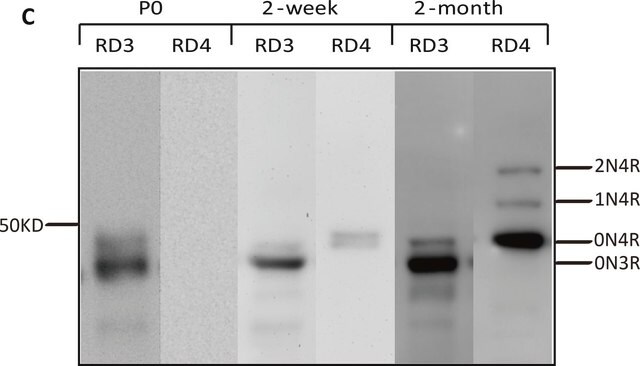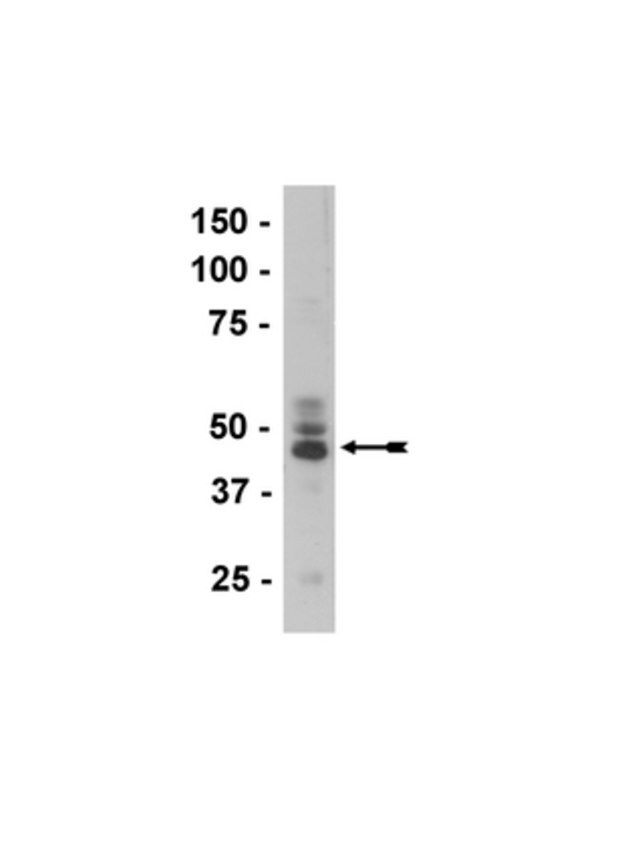您的位置:首页 > 产品中心 > Anti-Tau (3-repeat isoform RD3) Antibody, clone 8E6/C11
Anti-Tau (3-repeat isoform RD3) Antibody, clone 8E6/C11

| 产品编号: | 4085229 |
| 规格: | culture supernatant, clone 8E6/C11, Upstate® |
| 包装规格: | 200 μL |
| 产品类别: | 进口试剂 |
| 品牌: | Sigma-Aldrich |
| 优惠价: | 立即咨询 |
产品别名
Anti-Tau (3-repeat isoform RD3) Antibody, clone 8E6/C11
G protein beta1/gamma2 subunit-interacting factor 1, Neurofibrillary tangle protein, Paired helical filament-tau, microtubule-associated protein tau, microtubule-associated protein tau, isoform 4.
基本信息
| eCl@ss | 32160702 |
| NACRES | NA.41 |
| General description【一般描述】 | Microtubule Associated Proteins, or MAPS, bind to the tubulin subunits of microtubule structures and regulate their functional stability. In the cell MAPs bind to monomer and multimerized tubulin. MAP binding to multimerized tubulin further stabilizes the formation of higher order microtubulin structures. MAP binding to microtubule structures is mediated through phosphorylation through Microtubule Affinity Regulated Kinase (MARK). Phosphorylation releases MAPs bound to microtubules, destabilizing the structure, driving it toward disassembly. There are predominately two MAP types, I, II. Type II MAP includes MAP2, MAP4, and tau and are found in nervous tissue. Six tau isoforms exist in brain tissue, and they are distinguished by their number of binding domains. Three isoforms have three binding domains and the other three have four binding domains. The binding domains are located in the carboxy-terminus of the protein and are positively-charged (allowing it to bind to the negatively-charged microtubule). The isoforms with four binding domains are better at stabilizing microtubules than those with three binding domains. |
| Specificity【特异性】 | Recognizes Tau (3-repeat isoform RD3), Mr 45-65 kDa. Higher MW bands (68-72 kDa) represent phosphorylated Tau. Cross-reactivity with mouse and bovine expected due to sequence homology. |
| Immunogen【免疫原】 | Bovine thyroglobulin conjugated synthetic peptide corresponding to amino acids 209-224 (KHQPGGGKVQIVYKPV) of human Tau (isoform RD3). In other isoforms of huTau this sequence spans amino acids 267-316, omitting the second repeat domain where it bridges RD1 and RD3. The immunizing sequence is identical in human, mouse and bovine. |
| Application【应用】 | Research Sub Category Neurotransmitters & Receptors Neurodegenerative Diseases Anti-Tau (3-repeat isoform RD3) Antibody, clone 8E6/C11 is an antibody against Tau (3-repeat isoform RD3) for use in IH & WB. Research Category Neuroscience Immunohistochemistry: This antibody has been reported by an independent laboratory to detect Tau (3-repeat isoform RD3) in autoclaved paraffin brain sections (de Silva, R., 2003). Differential Detection of Tauopathies: (Togo, T., 2002.) |
| Quality【质量】 | Routinely evaluated by western blot on rat brain cytosol fraction. Western Blot Analysis: A 1:1000-1:4000 dilution of this lot detected Tau (3-repeat isoform RD3) in lysates from rat brain cytosol fraction. |
| Physical form【外形】 | Unpurified Mouse culture supernatant containing 0.05% sodium azide. Frozen at -20°C. |
| Analysis Note【分析说明】 | Control Lysates from rat brain cytosol fraction. |
| Other Notes【其他说明】 | Concentration: Please refer to the Certificate of Analysis for the lot-specific concentration. |
| Legal Information【法律信息】 | UPSTATE is a registered trademark of Merck KGaA, Darmstadt, Germany |
产品性质
| Quality Level【质量水平】 | 100 |
| biological source【生物来源】 | mouse |
| antibody form【抗体形式】 | culture supernatant |
| antibody product type | primary antibodies |
| clone【克隆】 | 8E6/C11, monoclonal |
| species reactivity | human |
| manufacturer/tradename | Upstate® |
| technique(s) | immunohistochemistry: suitable western blot: suitable |
| isotype【同位素/亚型】 | IgG |
| NCBI accession no.【NCBI登记号】 | NM_016835 |
| UniProt accession no.【UniProt登记号】 | P10636 |
| shipped in【运输】 | wet ice |
产品说明
| Target description【目标描述】 | ~45-65 kDa; phosphorylated forms at 68-72 kDa |
| Storage and Stability【储存及稳定性】 | Stable for 1 year at -20°C from date of receipt. For maximum recovery of product, centrifuge the vial prior to removing the cap. Handling Recommendations: Upon first thaw, and prior to removing the cap, centrifuge the vial and gently mix the solution. Aliquot into microcentrifuge tubes and store at -20°C. Avoid repeated freeze/thaw cycles, which may damage IgG and affect product performance. Note: Variabillity in freezer temperatures below -20°C may cause glycerol containing solutions to become frozen during storage. |
| Disclaimer【免责声明】 | Unless otherwise stated in our catalog or other company documentation accompanying the product(s), our products are intended for research use only and are not to be used for any other purpose, which includes but is not limited to, unauthorized commercial uses, in vitro diagnostic uses, ex vivo or in vivo therapeutic uses or any type of consumption or application to humans or animals. |
安全信息
| Storage Class Code【储存分类代码】 | 10 - Combustible liquids |
| WGK | WGK 2 |





